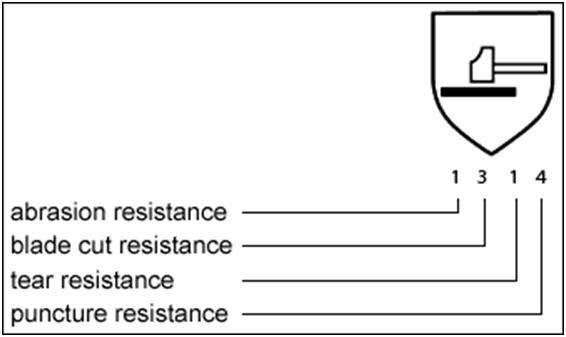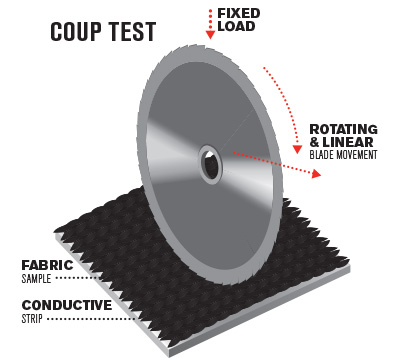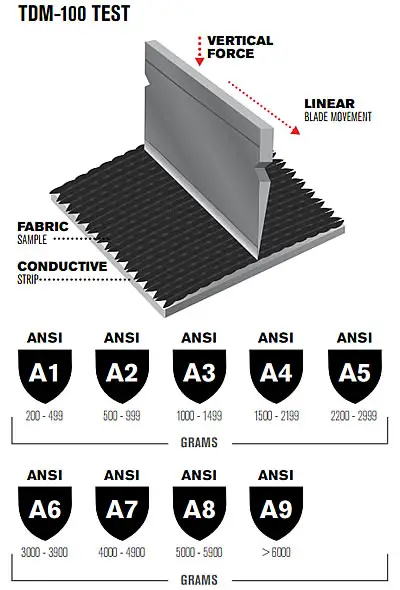Industrial-grade gloves and most other types of gloves usually have 4 numbers mentioned on them. Whether or not you paid attention is one thing, but these numbers are very significant when it comes to determining how safe, abrasion-resistant, tear-resistant, blade cut resistant, and puncture-resistant your gloves are.
Various manufacturers promise utmost protection and how their gloves are the best. But, it’s the 4-digit-number mentioned on your gloves that really matters. Also known as EN388 rating, these numbers indicate how much or little protection the gloves will offer.
Usually, you’ll find 4 numbers on your gloves. They basically indicate the strength of the gloves. The number 1 indicates the lowest level of protection and the number 4 means the gloves are extremely sturdy and resistant to all sorts of damages: abrasion, cut, puncture, and tear. So, the next time you buy a pair of gloves for workplace protection, do not forget to check out the EN388 rating.

The number 4 is usually the highest level of protection; however, in terms of resistance to cuts from blades and other sharp objects, this rating shoots up to 5 (5 is the highest level of protection from sharp objects such as glass). In fact, there are many revisions that are constantly made to the glove-safety rating parameter.
If you’ve been meaning to purchase high-quality gloves to keep your hands safe, this guide is a goldmine of answers. Expect to learn everything about the meaning of the 4 numbers on gloves: What are the EN388 testing parameters, does ANSI offer a similar rating index to determine the performance index of work gloves, some of the best industrial-grade work gloves you can buy, and much much more!
EN388 Testing Methods: How Are The Gloves Tested for Safety?
When you read the words EN388 tested on your gloves, be rest assured that they have been tested by a third party (not just the manufacturer) to properly determine and establish the strength and durability. There are basically 2 testing methods that are used to rate the gloves between 1 to 4: The Coup Test and the TDM 100 Test.
The Coup Test is one of the oldest methods used to test the cut resistance of the gloves. Earlier, a rotating blade was used to apply pressure on the gloves again and again until the gloves finally gave in and tore (or punctured).

Now, the safety limit has been increased. A glove passes the Coup Test only if it doesn’t tear before 60 attempts are made to cut it using industrial-grade rotor blades.
Anything below 60 isn’t considered strong enough, 60 being the lowest.
The TDM-100 Test, unlike the Coup test where a rotating blade is used to cut through the gloves, makes use of the powerful TDM-100 machine to cut through the gloves. It overcomes one of the biggest challenges that Coup Test Faces: the inability to cut through metal mesh and steel.

The latest testing method is a combination of both the Coup Test and the TDM-100 Test. The ratings derived from both these tests are used to label the gloves between the range of 1 to 4.
What do the 4 Numbers of Gloves Mean: A Detailed Chart Analysis!
The four numbers on the gloves indicate the safety and protection indexing. The higher the number, the safer and stronger the gloves are. However, the latest EN388 indexing has been revised to six numbers instead of 4. Have a look!
-
-
- The first number is 4. It stands for resistance against abrasion.
- The second number is 4. It stands for cut resistance.
- The third number is 4. It stands for tear resistance.
- The fourth number is 2. It stands for puncture resistance.
-
The latest two additions have been C and F or P or X. Here’s what they mean:
C is the fifth number. It means that the gloves are extremely resilient to both cuts and impact. They will stay intact up to 10 Newtons of force.
The 6th indexing is now being done to determine the exact impact resistance that the gloves can offer. If the 6th index is F, it means the gloves are not impact-resistant.
If it’s P, it means the gloves passed the impact resistance test. But, if it’s X, it means that the gloves have not been tested.
Glove Ratings According to ANSI
Although EN388 is the more common indexing method that’s used to determine the strength and quality of gloves, ANSI (American National Standards Institute) has come up with equivalent indexing of their own. Here’s what you need to know about this specific set of markings if you find it mentioned on your gloves:
A1 is the first marcation. It means that the gloves can withstand a cutting load ranging between 200 g to 499 g.
A2 is the second marcation. It means that the gloves can withstand a cutting load ranging between 500 g to 999 g.
A3 is the third marcation. It means that the gloves can withstand a cutting load ranging between 1000 g to 1499 g.
A4 is the fourth marcation. It means that the gloves can withstand a cutting load ranging between 1500 g to 2199 g.
A5 is the fifth marcation. It means that the gloves can withstand a cutting load ranging between 2200 g to 2999 g.
A6 is the sixth marcation. It means that the gloves can withstand a cutting load ranging between 3000 g to 3999 g.
A7 is the seventh marcation. It means that the gloves can withstand a cutting load ranging between 4000 g to 4999 g.
A8 is the eighth marcation. It means that the gloves can withstand a cutting load ranging between 5000 g to 5999 g.
A9 is the ninth marcation. It means that the gloves can withstand a cutting load of 6000 g or more.
Now that you know what the index values and the 4 numbers on your gloves mean, let’s take you through the many reasons why you should take these marcations seriously.
Why Should You Be Fussy About the Numbers and Indexing on Your Gloves?
Working with your hands brings all sorts of risks. Depending upon the industry you work in, gloves are the only real protection that you’ll have. The many reasons why you should be picky when choosing work gloves are as follows.
1.) High grading gloves are the best options for risky workplaces such as automotive jobs, warehousing jobs, and construction jobs.
It is very important that the gloves you wear are impact-resistant and the only way to be doubly sure that you’re being supplied with genuine quality is when the gloves have either an ANSI rating or EN388 rating.
2.) If you work in an industry that exposes your hands to chemicals (laboratory technicians, doctors, sanitation workers, and archeological conservative-restorers), it is very important that you wear gloves that have high gradings for abrasion resistance.
If you want abrasion-resistant gloves for cleaning at home, you can count on level 1 or level 2 gloves. But, for industrial-grade work, the higher the number, the better it is.
3.) One of the common reasons behind workplace injuries that workers sustain is because the gloves are easily punctured. This is why you should be fussy about buying the gloves that are tested with both the Coup test and the TDM-100 test.
4.) Last, but not least, gloves with high ratings are the best protection against cuts and scrapes.
3 Best High-Grade Gloves You Can Trust for Heavy-Duty Industrial Purposes
1.) The Vgo ANSI Level 3 Cut Resistant Gloves
- Ideal for regular construction, glass industry, building, wiring, automobile industry, fencing
- Hypro fiber seamless glove for high cut resistance at EN388 level C, ANSI level 3
- Polyurethane dipping allows the transpiration and enhances grip capacity, also brings high durability
Prices pulled from the Amazon Product Advertising API on:
Product prices and availability are accurate as of the date/time indicated and are subject to change. Any price and availability information displayed on [relevant Amazon Site(s), as applicable] at the time of purchase will apply to the purchase of this product.
These hand gloves are EN388 Certified and they’re ideal for people who work in the glass industry, fence building and installing, or are electricians. In fact, you can also use these gloves as gardening gloves too.
They’re super comfortable to wear since they’re seamless. They easily glide in and are equally easier to remove.
They wick moisture and offer a very good grip while working.
The polyurethane dipping on these gloves makes them extremely durable and long-lasting.
Since they’re reusable, they’re highly cost-effective.
Cons: Some consumers report that these gloves run one size smaller. So, be careful and refer to the size chart as provided by the company.
Check Price and Reviews on Amazon2.) The Pakel Y-01-08 High Performance Industrial-Grade Gloves
- Palm and fingers polyurethane dipped for better protection
- Made with special fiber which is also used as resistant fiber in personal armor, bow strings etc.
- Knit wrist, lightweight, flexible, cool and comfortable
- Can be used in demolition, automotive, glass, construction, metal working, handling sharp materials and objects
Prices pulled from the Amazon Product Advertising API on:
Product prices and availability are accurate as of the date/time indicated and are subject to change. Any price and availability information displayed on [relevant Amazon Site(s), as applicable] at the time of purchase will apply to the purchase of this product.
These are high-level cut-resistant gloves that offer level 5 protection. They are EN388 certified, true to their size, and extremely durable.
With high-level cut protection of level 5 index, these hand gloves are excellent protection for workers involved in industries like demolition, glass, construction, metal working, and automotive.
Other than being cut-resistant, they are rated 4 in abrasion resistance, 4 in tear resistance, and 3 in puncture resistance. Needless to say, they are one of the very best protection gloves in the market.
Consumers have reported that these gloves didn’t give in even when they were used for wood splitting and pulling out sharp thorns and twigs.
Cons: Not any substantial cons have been reported as such. Some consumers did complain that the gloves lost efficiency after washing.
However, the manufacturers have already mentioned that the gloves should be washed with cold water only. As long as you stick to this protection, these gloves will really last for a long time.
Check Price and Reviews on Amazon3.) Seibertron HIGH-VIS HDC5 Deckhand Gloves
- Choose the size by the left size chart image
- CUFF PULLER, Get your glove in the proper position faster
- Additional Features: Reflective tape on the wrist, One-Piece Palm with dual Kevlar threads stitching, Extended neoprene, HIGH-VIS palm and back of hand
- Best uses, Rigging, Oil and Gas Drilling, Extraction and Refining, Fracking, Tool Pushing, Mining, Demolition, Heavy Construction
Prices pulled from the Amazon Product Advertising API on:
Product prices and availability are accurate as of the date/time indicated and are subject to change. Any price and availability information displayed on [relevant Amazon Site(s), as applicable] at the time of purchase will apply to the purchase of this product.
These are exceptional cut-resistant gloves that offer level 5 protection. That’s not all! They’re highly resistant to abrasion as well. Needless to say, it makes them oil-resistant too.
Not only are they EN388 certified level 5 gloves, but they’re also level 4 gloves as certified by ANSI/ISEA.
They’re one of the safest gloves that can be used for heavy-duty construction work. Other industries where these gloves are of high value include rigging, mining, oil and gas drilling, extraction and refining, tool pushing, and demolition.
They’re fabricated with a reflective tape on the wrist that offers proper grip and support. So, the gloves won’t roll up (fold) while you’re working.
They absorb as much as 90% of force from a heavy impact, protecting your fingers, palms, as well as knuckles.
Cons: The only visible Con is their price. They’re more expensive than most other gloves. However, the price justifies the kind of protection they offer. Besides, since they last for a long time, they are worthy investments.
Check Price and Reviews on AmazonConclusion:
The 4 numbers on gloves are the indexing that reflects how strong the gloves are. Level 1 offers the lowest protection and level 4 offers the highest protection. These ratings (numbers) are assigned after the EN388 testing.
However, there are more numbers and ratings that have been lately added in addition to the 4 numbers that are already present on the gloves. These new numbers are equally important since they define the impact resistance of the gloves.
Besides, the new indexing also identifies whether or not the gloves are tested by a third party and if tested, whether or not they passed the impact resistance test.
So, when you buy an industrial-grade glove to protect your hands at the workplace, it’s better to be fussy and look for suitable options.










